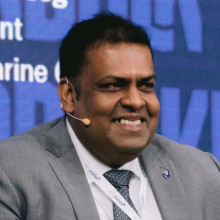Nov 13 | 2024
Al Faris, deugro, Bahri and DSV Share Insights on Key Challenges Facing Region
_1.jpg)
By Simon West
Following an overview by the Energy Industries Council (EIC), project professionals offer their perspectives on crucial topics such as infrastructure development, key sectors, freight rates and sustainability in the region.
From Breakbulk Magazine’s Issue 6, 2024 Global Outlook series.
EIC Analysis:
Oil and gas opportunities are projected to grow in both regions, particularly in natural gas and deepwater wells, with upstream projects comprising almost 60% of total CAPEX. Global decarbonization trends are accelerating interest in hydrogen for synthetic fuels and low-carbon applications, but geopolitical tensions and shipping disruptions pose risks to this growth.
In the Middle East, the oil and gas sector remains dominant, with US$730 billion in additional CAPEX expected by 2030. This is driven by increased gas production and oil output maintenance for stable profits. As energy demand rises and oil prices stabilize, national companies are heavily investing in both traditional and renewable energy technologies. Upstream investments, which account for over half of the projected CAPEX, are concentrated in the UAE, Iraq and Saudi Arabia. A good example is Saudi Aramco which is advancing gas projects such as Jafurah, Rub Al-Khali and its Master Gas System.
In Africa, the sector is expanding through new discoveries in Zimbabwe, Ivory Coast, and Namibia, alongside increased gas production in Sub- Saharan Africa. Nigeria has secured Final Investment Decision (FID) for eight major projects, while Namibia’s Orange Basin is becoming a deepwater hotspot, though commercial output has not begun. Angola leads upstream investments through 2030, while Mozambique advances as a liquified natural gas (LNG) exporter with the Rovuma LNG and Coral Norte floating liquefied natural gas (FLNG) projects, both expecting FID by 2025.
Hydrogen development also shows promise, with Saudi Arabia’s US$5 billion Helios Green Fuels plant and Oman’s goal to produce one million tons per annum (mtpa) by 2030. Jordan and the UAE are exploring hydrogen initiatives, while Africa’s market remains less mature. North Africa could export hydrogen to Europe, and South and East Africa may export ammonia. However, financing gaps, infrastructure issues, and governance risks hinder progress, with only 17% of hydrogen projects beyond feasibility and just 4% having reached FID.
Q&A With Local Leaders
1. What is your business outlook for 2025?
 Kieve Pinto, chief operating officer (COO), Al Faris:
Kieve Pinto, chief operating officer (COO), Al Faris:We foresee strong growth driven by continued infrastructure development, energy projects and industrial expansion across the Middle East. Abu Dhabi’s oil and gas sector, particularly through ADNOC’s expansion projects, will play a key role in this growth. The emphasis on renewable energy, alongside traditional oil and gas and petrochemical projects, will drive demand for heavy lifting and transport services. Al Faris is well-positioned to meet these needs, and we are expanding our fleet and technological capabilities to support these large-scale ventures.
Rajith Aykkara, vice president, Bahri Line:

The outlook for 2025 is highly optimistic. We anticipate adding more vessels to our service, which aligns with our growth strategy in key trade lanes across the region and globally. With increasing demand, especially in the Middle East and Asia, we are confident that our expanded fleet will see high utilization rates in our trade lines, driven by both ongoing and emerging project opportunities. This positions us well to continue meeting the evolving needs of our customers and reinforcing our market presence in the region and beyond.
 Steffen Behrens, president, deugro Middle East:
Steffen Behrens, president, deugro Middle East:The business outlook for capital project logistics in the Middle East remains very positive, with government spending on capital investments expected to increase by more than 6.5% next year. This growth is driven by several factors including economic recovery, infrastructure development and megaprojects. For example, Saudi Arabia’s construction output value is expected to reach US$150 billion by 2025. With a 4% growth rate for the MENA region in 2025 we are still well above most other regions, therefore overall indicating a strong economic environment for capital project logistics.
Mohammad Jaber, MD, Air and Sea, DSV Abu Dhabi:

Abu Dhabi is expected to maintain robust growth in its project logistics sector by 2025, driven by significant investments in infrastructure, energy and construction, such as the Hail and Ghasha project and Borouge 4. Key initiatives such as the Abu Dhabi Economic Vision 2030 and the “Made in UAE” focus will further boost demand for project logistics. The sector will also benefit from ongoing developments in oil and gas and renewable energy across the UAE and the GCC, as well as transportation infrastructure and urban development projects.
These developments will open up opportunities for specialized project cargo solutions and enhanced supply chain services. Megaprojects like Hail and Ghasha will significantly increase volumes over the next three years. The growing demand for the fabrication of modules, oil and gas project skids, and pressure vessels in the UAE to supply projects across the region and Europe, driven by the cost competitiveness of the UAE, will continue to play a key role. However, geopolitical conflicts may continue to add cost pressures until these issues are resolved.
2. What sectors or specific new projects in your region do you think will be significant for breakbulk and project cargo in the coming year?
Pinto:
Key sectors include oil and gas, renewable energy (solar and wind) and infrastructure. In Abu Dhabi, ADNOC’s major ongoing projects such as the Hail and Ghasha gas development, Ruwais LNG and the expansion of offshore oil fields will significantly increase the demand for project cargo services. Additionally, large projects like NEOM and the Red Sea Development in Saudi Arabia will require extensive heavy lifting and specialized logistics for breakbulk cargo, which Al Faris is well-equipped to handle.
Aykkara:
The energy sector will remain a major driver, with new developments in both oil and gas and renewables. Megaprojects within Saudi Arabia’s Vision 2030, such as NEOM and Red Sea developments, are expected to require extensive logistics and transport solutions, which will boost demand for breakbulk services. Additionally, the expansion in industrial sectors and infrastructure across the Middle East region will further support activity in our sector.
Behrens:
It will mainly remain with the oil and gas sector, although with a healthy mix of renewables and obviously new sectors such as green hydrogen, which deugro is heavily involved in already.
Jaber:
Several sectors will drive breakbulk and project cargo growth in the Middle East over the next few years. In the energy sector, the expansion of oil and gas facilities – including new refineries and offshore drilling projects – continues, particularly in the UAE and Saudi Arabia, with several packages already awarded. In renewable energy, large-scale solar and wind power projects, especially in the UAE and Saudi Arabia, will drive logistics demand. Elsewhere, megaprojects such as NEOM in Saudi Arabia, the Expo 2020 legacy projects in Dubai, new airport construction and GCC railway network expansions will significantly increase volumes over the next five years.
3. Do you think the existing infrastructure (ports, terminals, vessels) in Asia is prepared to handle the demand for breakbulk and project cargo? What improvements or resources are needed, if any?
.jpeg) Pinto:
Pinto: The region’s infrastructure has seen considerable investments, particularly in ports like Jebel Ali in the UAE and Khalifa Port in Abu Dhabi, which are equipped to handle high volumes of breakbulk and project cargo. However, with increasing demand from projects such as ADNOC’s oil and gas expansions and other large industrial projects, further capacity expansion and advanced handling technology will be needed. Enhancing automation, streamlining customs procedures and upgrading equipment at ports will ensure the region remains competitive and capable of handling future demands.
Aykkara:
While the Middle East has made strides in enhancing port infrastructure and handling capabilities, there is still room for improvement. Ports and terminals are progressively adapting to the unique demands of breakbulk cargo, but expanding fleet capacity, modernizing equipment and digitalizing processes would further strengthen our ability to meet growing demand. This preparation will be crucial as project cargo often involves high-value, oversized equipment requiring specialized handling.
Behrens:
We do already see new developments coming up such as the port of NEOM in Saudi Arabia, extensions in Abu Dhabi and plans for some of the eastern ports of Oman.
Jaber:
The region has made substantial investments in modernizing and expanding its port infrastructure. Ports such as Jebel Ali, Khalifa Port and King Abdullah Port are equipped with state-of-the-art facilities to handle breakbulk and project cargo. However, ongoing improvements in technology, automation and capacity expansion are needed to meet rising demand. Additional rail connections to industrial areas and the development of dry ports could optimize freight costs and improve sustainability strategies.
Meanwhile, specialized vessels for heavy-lift and project cargo are increasingly available in the region, but further investments in larger and more advanced vessels are required. Planning for increased demand is crucial, particularly due to the longer routes some vessels must take to avoid Red Sea challenges, which remove tonnage from the market. Handling oversized cargo (exceeding 1,000 metric tons) adds further complexity. However, improvements are needed, such as in automation and digitalization of port operations and customs interfaces, training programs to improve workforce skills, infrastructure investments for handling oversized cargo and enhanced intermodal connectivity.
4. What trends are you seeing in freight rates, and do you anticipate these changing?
Pinto:
Freight rates have been volatile due to global supply chain disruptions, fuel prices and geopolitical factors. In the Middle East, rates are expected to stabilize over 2024-2025 as global shipping conditions improve. However, the sustained demand for project cargo, particularly from the oil and gas sector in Abu Dhabi and other regional megaprojects, may keep upward pressure on rates. Fuel prices, vessel availability and environmental regulations will also influence freight rate trends.
Aykkara:
Freight rates have stabilized compared to recent years, but geopolitical and economic shifts can always impact pricing. We anticipate that rates may remain somewhat volatile, given the ongoing global economic adjustments. However, I expect regional carriers to adapt through flexible solutions tailored to customer needs.
Behrens:
Unfortunately, at the moment, it’s all a bit subject to geopolitics and regional stability. We obviously hope that things calm down and we can revert to a more stable rate environment again in order to deliver projects on time and on budget.
Jaber:
Freight rates have been volatile due to global supply chain disruptions from the pandemic, geopolitical tensions and fluctuating fuel prices. This creates challenges for EPC projects, especially in fixing long-term rates. The cost of insurance, longer transit times (particularly through the Red Sea) and rate fluctuations make it difficult to maintain contracts. DSV has experienced significant delays, rate hikes and even cargo held for months in Iran in arrested vessels, impacting customers SLAs. Freight rates are expected to stabilize in the near future as supply chains adjust, but rates may remain higher than pre-pandemic levels due to inflation, fuel prices and the peak in project activities over the next few years. However, geopolitical tensions could lead to further disruptions.
5. What are the biggest challenges for your sector in the year ahead, and how is your company preparing to navigate them?
Pinto:
_1.jpg) One of the biggest challenges will be meeting the high demand for heavy lifting and transport services driven by large-scale projects in oil and gas, infrastructure and renewable energy sectors. In response, Al Faris is making significant investments in expanding our fleet. We are bringing in more mobile cranes and have already invested in new axle lines, which will be delivered in 2025 to meet increasing demand. We’re actively investing in both the UAE and Saudi, ensuring we have new equipment to support future projects. Additionally, we are continuously upgrading our technological capabilities and workforce skills to ensure we can tackle complex projects efficiently and sustainably.
One of the biggest challenges will be meeting the high demand for heavy lifting and transport services driven by large-scale projects in oil and gas, infrastructure and renewable energy sectors. In response, Al Faris is making significant investments in expanding our fleet. We are bringing in more mobile cranes and have already invested in new axle lines, which will be delivered in 2025 to meet increasing demand. We’re actively investing in both the UAE and Saudi, ensuring we have new equipment to support future projects. Additionally, we are continuously upgrading our technological capabilities and workforce skills to ensure we can tackle complex projects efficiently and sustainably.Aykkara:
Among the primary challenges are managing supply chain resilience and accommodating increased environmental regulations. Bahri is focused on streamlining logistics processes, investing in technology for efficiency and preparing for shifts in regulatory compliance. Moreover, we’re looking closely at alternative energy options for shipping and transport to align with sustainability goals.
Behrens:
Regional instability and geopolitics where you have to have contingency plans in place.
Jaber:
Firstly, unpredictable disruptions, particularly from geopolitical conflicts in the Middle East, affect transit times and costs. Regulatory changes and shifts in trade policies and customs regulations also add operational complexity. We must also consider how rapid advancements in technology require ongoing change and investment. Building resilience, investing in technology, and focusing on training and development are all ways we can prepare for and mitigate these challenges.
6. Is the balance between global and regional supply chains changing, and, if so, in what ways?
Pinto:
Yes, regional supply chains are becoming more prominent due to initiatives like the UAE’s in-country value (ICV) and Saudi Arabia’s Vision 2030, which emphasize local sourcing. In Abu Dhabi, for example, ADNOC’s ICV program encourages local content and service providers, shifting the balance more toward regional supply chains. Al Faris is adapting to this shift by strengthening partnerships with local suppliers and manufacturers to ensure we can meet the rising demand efficiently and sustainably.
Behrens:
We definitely see a push towards Asia, be it on the contracting side or on the investment side, and we believe this will also continue in the future.
Aykkara:
We are indeed seeing a recalibration between global and regional supply chains. There’s a growing emphasis on establishing more resilient, localized supply networks within the Middle East, which reflects both economic strategy and recent shifts in global logistics dynamics. This evolution provides opportunities for regional players to enhance their role within the global market.
Jaber:
The balance between global and regional supply chains is shifting due to several factors: Firstly, there is an increased focus on regional supply chains to reduce dependence on distant sources, enhance reliability and lower transportation costs. DSV is highly involved in local manufacturing, supporting government initiatives such as in-country value programs. Nearshoring, where production is moving closer to consumption markets to mitigate global disruptions, and the region’s modern infrastructure, especially in power supply, supports this shift. We also have trade agreements such as the Abraham Accords that will boost regional trade networks, particularly with railways connecting Asia, the Middle East and Europe.
Finally, regional logistics infrastructure and technology are improving, making local supply chains more viable. The GCC railway network will be a game-changer in the next five years. At DSV, our systems provide clients with greater supply chain visibility and advanced options like PO and order management, with over 2000 RPAs in operation. In conclusion, while challenges persist, the Middle East’s logistics landscape will see significant growth driven by regional investments and development. Adaptation, infrastructure investment and embracing technological advancements will be critical for companies to thrive.
Read more in the series:
Global Outlook: Asia
Global Outlook: Europe
Global Outlook: Americas
PHOTO CREDIT (TRANSPORTS): Al Faris
